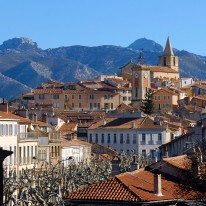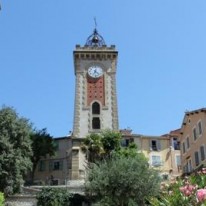Aubagne
The county of Aubagne is located in a very touristic region, Provence-Alpes-Côte d'Azur, close to Marseilles and only a few miles from the Mediterranean Sea (Cassis and La Ciotat).
It is surrounded by hills and mountains. On the North, by the Etoile and the Régagnas mountains; on the West, by the famous Garlaban mountain; on the Southern-East, by the Sainte Baume.
The county is crossed by the Huveaune river (except for Cuges-les-Pins).
The county of Aubagne is composed by 12 towns and villages: Aubagne, Auriol, Belcodène, Cadolive, Cuges-les-Pins, La Destrousse, La Bouilladisse, La Penne sur Huveaune, Peypin, Roquevaire, Saint Savournin and Saint Zacharie.
It counts more than 100,000 inhabitants.
Distances between Aubagne and...
| Cassis : 14 km | La Ciotat : 16 km |
| Marseille : 17 km | Aix en Provence : 36 km |
| Toulon : 46 km | Lyon : 333 km |
| Paris : 795 km |
Aubagne
The cultural identity of Aubagne has two major themes: Marcel Pagnol (a famous writer, member of Académie Française) and Clay.
In the heart of the old town, the architectural heritage, dating from the 11th century, is another important reason to come and discover Aubagne.
The County of Aubagne has a long-lasting tradition: the work of clay. This culture is common to the whole Valley of Huveaune: very diversified crafts in Aubagne (porcelain, sandstone, glazed earthenware, 'santons'), earthenware in Roquevaire, common-use and architectural potteries in Saint Zacharie, bricks and tiles in Auriol.
Nowadays, the County of Aubagne is the symbol of a very lively crafts, which is a real economic asset.
On the whole territory, 70 workshops or firms connected with clay activity can be found. They represents about 200 jobs and an annual turnover of more than 10 millions Euros.
Two kinds of crafts can be found in this area:
- Ceramic: very diversified, it has a more than 7-centuries-old tradition.
- Santon: a classical and traditional object, created by the end of the 18th century.
Let's talk about clay...
Since Antiquity, the soil of Aubagne has always been exploited. Pre Roman, Roman amphorae and fine ceramics were made at this period.
Since the 13th century, this activity has never stopped with the making of tiles, the creation of the enamel, of the first cicadas by Louis SICARD, which are today the symbol of Provence, of the famous "Santons" (little clay figurines for cribs) by Thérèse NEVEU and the floor-tiles, created by Italians from Salerna.
Even prestigious works such as the decoration of « Le Normandie », « Le France » and the « De Grasse » ocean liners were made in the firms of our town.
Today, some 70 ceramists and santons-makers work in the typical narrow streets of our old city or in the surroundings. They are part of the economic and cultural heritage of Aubagne.
A few historical notes
1st Century B.C: Finding of a potter's wheel in Saint Jean de Garguier, a hamlet belonging to the village of Gémenos, by Aubagne.
13th Century: Little pieces of Clay ceramic are found by the walls of the rampart of the castle of Aubagne (by the church).
A 1212 text notifies the existence of a kiln and a tiles-factory by the castle. We haven't found so far any object which could confirm these facts, but we think that the objects made at this time were useful items and tiles.
This activity dealing with the Ceramic, from Antiquity, has been furthered by the presence of 3 important elements, found in our region:
- clay, which can be easily modelled,
- water, needed to model the Clay,
- wood, needed for the fire of the kiln.
16th Century: The local production in Aubagne is testified by a sale-contract between Bruno Catani, a qualified tiles-maker but also a potter, and a salesman from Pertuis. This was, then, the beginning of a slow economic development, helped by the workshops of Saint-Zacharie (a village, a few miles in the North of the Valley of the Huveaune). The objects made then were essentially useful items.
19th Century: It was named the Golden Age of Aubagne because of the increase of the number of workshops, of the diversification of the production (enamelled pottery, earthenware, decorative objects, wall-tiles, and tiles...)
End of the 19th Century: At this period, many events gave to Aubagne its lasting image of Capital of the Clay with a very important development of the architectural ceramic (tiles, walls and floors tiles...).
Years after years, firms were built; dozens of big chimneys could be counted. The industrialization was developed. The ceramic activity gave work to most of the inhabitants. It created a « blue-collar culture » at the beginning of the 20th century.
1895: Louis Sicard created his first earthenware cicada. Many copies of it will be made by the eve of the 20th Century.
The end of the 19th Century is a period of development of the santons production with the creation of the Thérèse Neveu's workshop.
20th Century: It was a period of progressive decline of the architectural ceramic activity, between the two World Wars. Many firms changed their activities or just disappeared.
From 1950 to 1990: Some 15 firms succeeded in finding their balance, including the Ravel firm which has made a successful change of activity in the making of garden pottery.
Since 1990: A new economic development can be noticed with the creation of new workshops.
Ceramic in Aubagne
The word "ceramic" includes all the industries dealing with clay and fire: tile-manufacturing, pottery, earthenware, porcelain and stoneware.
Aubagne has produced and has been famous in the 3 first categories. The soil of Aubagne furnishing a clay of high quality, tiles, bricks and floor tiles were the very first objects made, as soon as the Gallo-Roman period.
In 1531, the very first potter making enamelled pottery was registered in the cadastre. In 1666, Aubagne had 2,000 people working for the ceramic activity out of 8,000 inhabitants. Nevertheless, we had to wait for 1750 to see earthenware craftsmen settle. They made a production of quality based on the famous Moustiers earthenware, using white enamel which made possible the making of magnificent sceneries.
During the 18th Century, the Richelme firm, specialized in earthenware, exported 12 tons a year to the Antilles... Big jars used as tinned were also exported to the Guadeloupe. This trade was so important that a port named one of its quays "the quay of Aubagne".
The 19th Century is the time of the tremendous expansion of the ceramic of Aubagne: the town had at that time 40 pottery firms and 12 earthenware firms.
One of the most popular workshops was SiméonAubert's, thanks to his gifted decorator, Léon Mazières whose one meter-diameter plate still decorates the stairs of our town-hall. The Cantini Museum in Marseilles owns some objects of the ancient productions of Aubagne.
In the same time, the making of wall tiles had a fantastic increase: from the end of the 19th Century to the beginning of the 20th Century, our local firms exported up to
150. 000 wall tiles a day.
With the creation of new techniques, this activity decreased and stopped, craftsmen took over.
The "Matisse white" was born in Aubagne, at the Proceram firm, now disappeared. There, Henri Matisse created plates of red clay used to receive the extremely pure white enamel, on which he was to draw a magnificent Virgin with the Child, a giant Saint Dominic and a Cross path that thousands of tourists come and see at the chapel of Saint Paul de Vence. At the Proceram firm were also created the decorating elements for the swimming pools of the "De Grasse", "Vietnam" and "France" ocean liners, as well as the decorating elements of the Orly and Abidjan airports. Many artists came to Aubagne to decorate or to create their works: Fernand Léger, Pignon, Pierre Ambrogiani, Visenz...
Nowadays our productions are very famous and various: garden pottery, enamelled pottery, Provence-style plates and objects, decorative earthenware, architectural earthenware, reproductions of Vieux Marseilles and Moustiers' style, of amphorae, bright coloured objects, decorated with a cicada, objects for the bathroom or for the kitchen...
The art of the ceramist cannot be compared. Thanks to his talent, the clay takes the most simple and beautiful shapes. This art is more than secular, and the ceramists of Aubagne know everything about it. These craftsmen are a part of this Nobility of the Clay which, from generation to generation, brings to Aubagne an incontestable fame.
The Santons
What happened during the mysterious night of the Nativity has always puzzled men. By several forms of art, they have given many interpretations of it.
Saint François d'Assise (1182-1226), whose mother was from Provence (Dame Pica Bernadone de Tarascon), is said to be the creator of the first living crib. In 1223, with the Pope's authorization, he had the idea to invite the friars of Greccio, a little village of the Arbruzzes, during the Christmas night, to a cave where had been settled a living crib, with an ox and a donkey.
During the 17th Century, in order to people to go back to church since they had lost "their way" because of the protestant reform, cribs were made and this custom increased during the next century. To the characters of the Nativity were added others, such as shepherds and so on...These characters were first made of wood, then wax, and even in barbed wire (making real statues dressed with nice clothes). These were the ancestors of our dressed "santons".
In the same time, the noble and the rich put costly cribs in their castle, made of glass or soft part of the bread. These cribs were first imported from Italy, like the Santibelli (beautiful saints), representing only religious characters. But very soon, they were made in Nevers, where glass-craftsmen, coming from Venice, settled. But only the rich could afford these objects.
During the French Revolution, Jean-Louis Lagnel, from Marseilles, was an expert in moulding the most beautiful statues to reproduce them in plaster. This man had the idea to model little figurines representing the characters of the crib in a modest and cheap material: clay. Moreover with this technique of moulding, he could reproduce his model as many times as he wished. The first santons (little saints) were born, and anyone could afford them. Since then, any family could own its own Christmas crib. At the origin, the traditional crib was elaborated with Nativity characters (Joseph, Mary and the infant) and with the Wise Men. But soon, many new characters were added, characters from public talking cribs, real shows, and from the MAUREL Pastoral, created in 1844, at the Nau street of Marseilles, and since then, played during the Christmas period, in many Provence towns and villages.
Today, raw santon has been replaced by fired santon (at 1,000 degrees). The character is first modelled in clay and then moulded between two shells of plaster. It then can be reproduced as many times as it is wished, and then painted after having been fired in the kiln, or dressed.
Painted or dressed, the santon is faithful to the traditional Provence outfit, from the Restoration period (19th century).
In 1894, the Great Lady of the Clay, Thérèse NEVEU, the santons-maker of Aubagne, the ceramist Louis SICARD's sister (the creator of the famous Provence cicada) had the idea to produce in clay, the features and silhouette of a famous person: Virginia of the Garlaban. She showed the way to these creators who, days after days, model with love, patience and talent our beautiful Christmas santons which are, according to the poet Elzéard ROUGIER: "flowers we pick up in winter".






